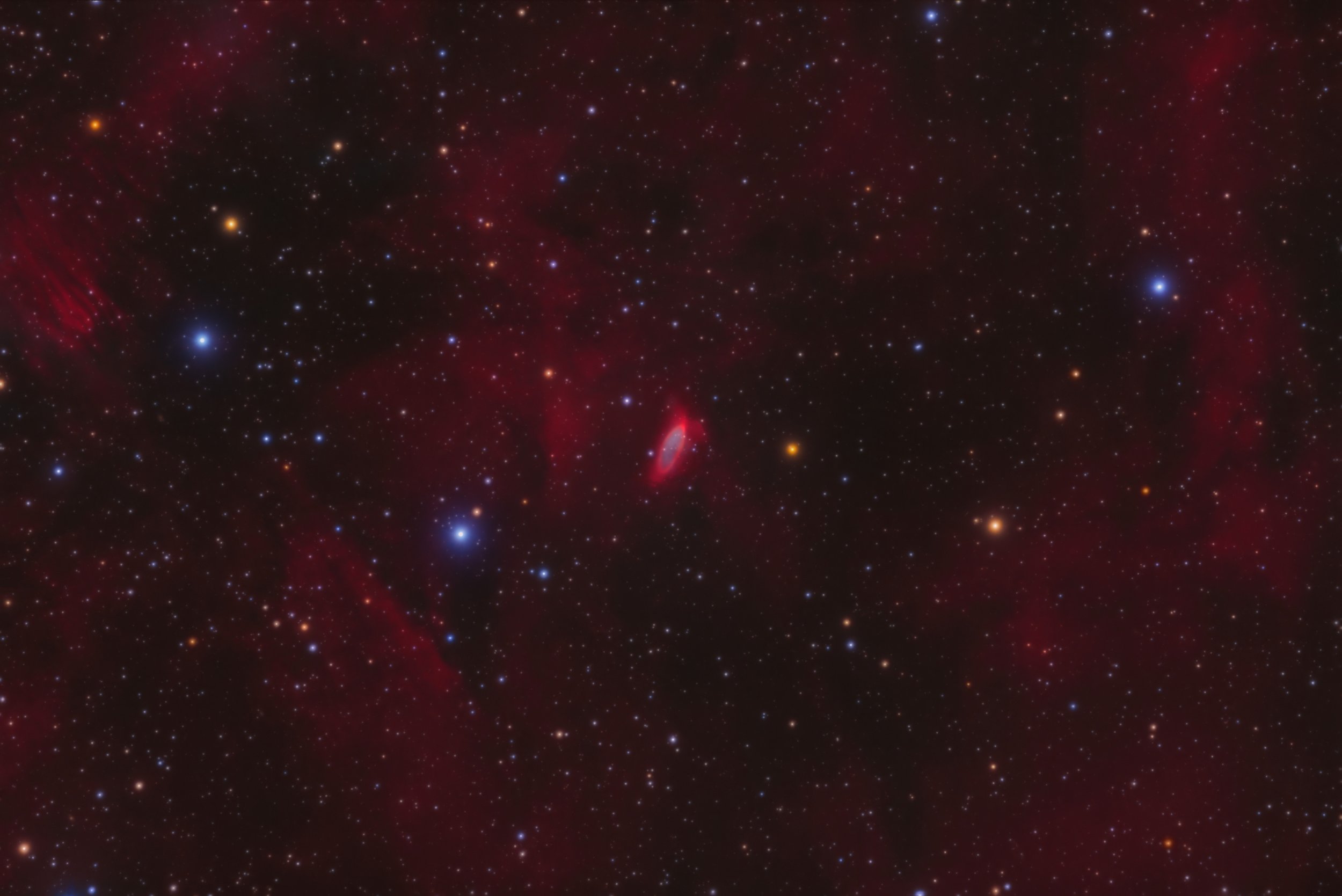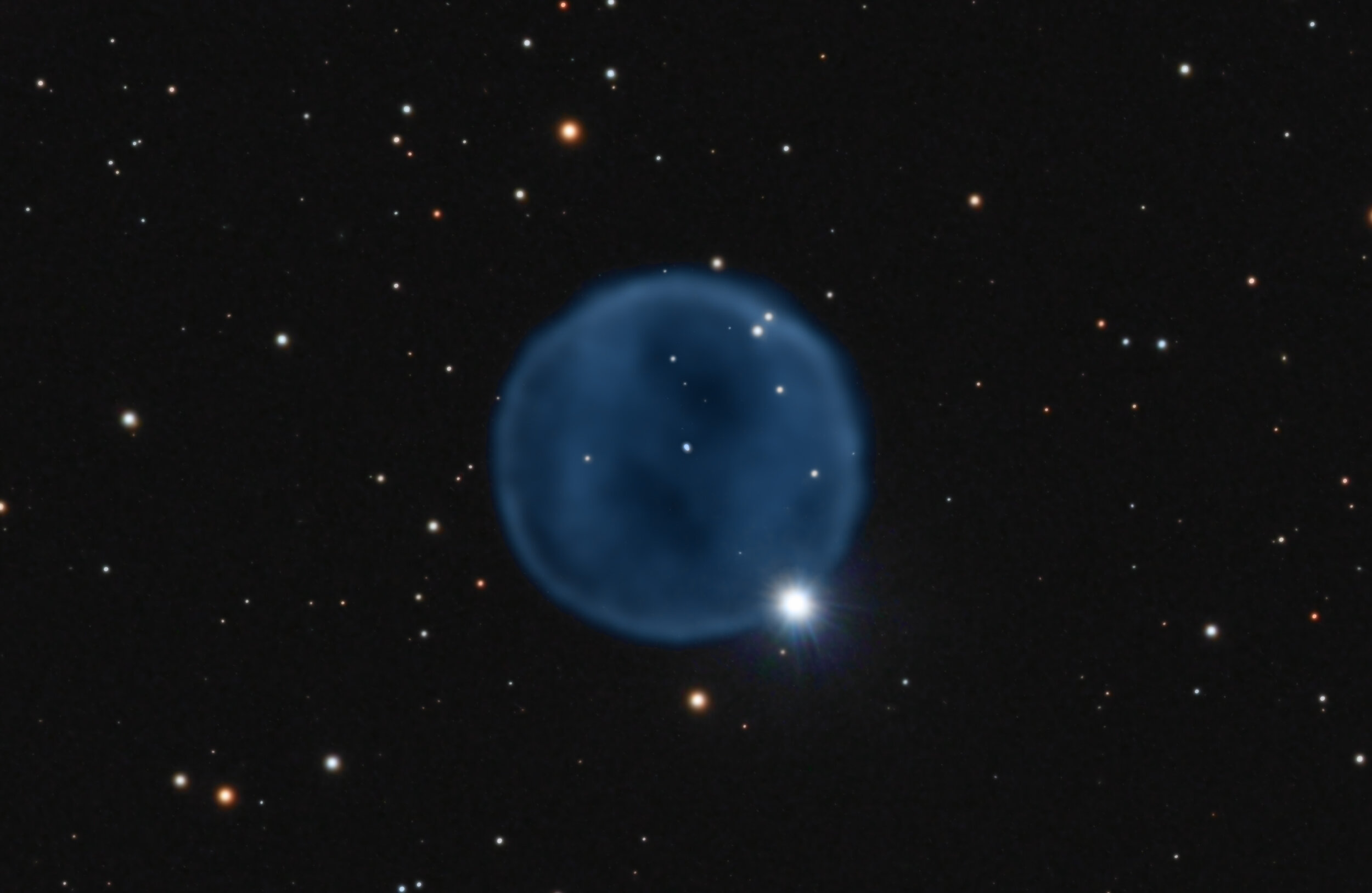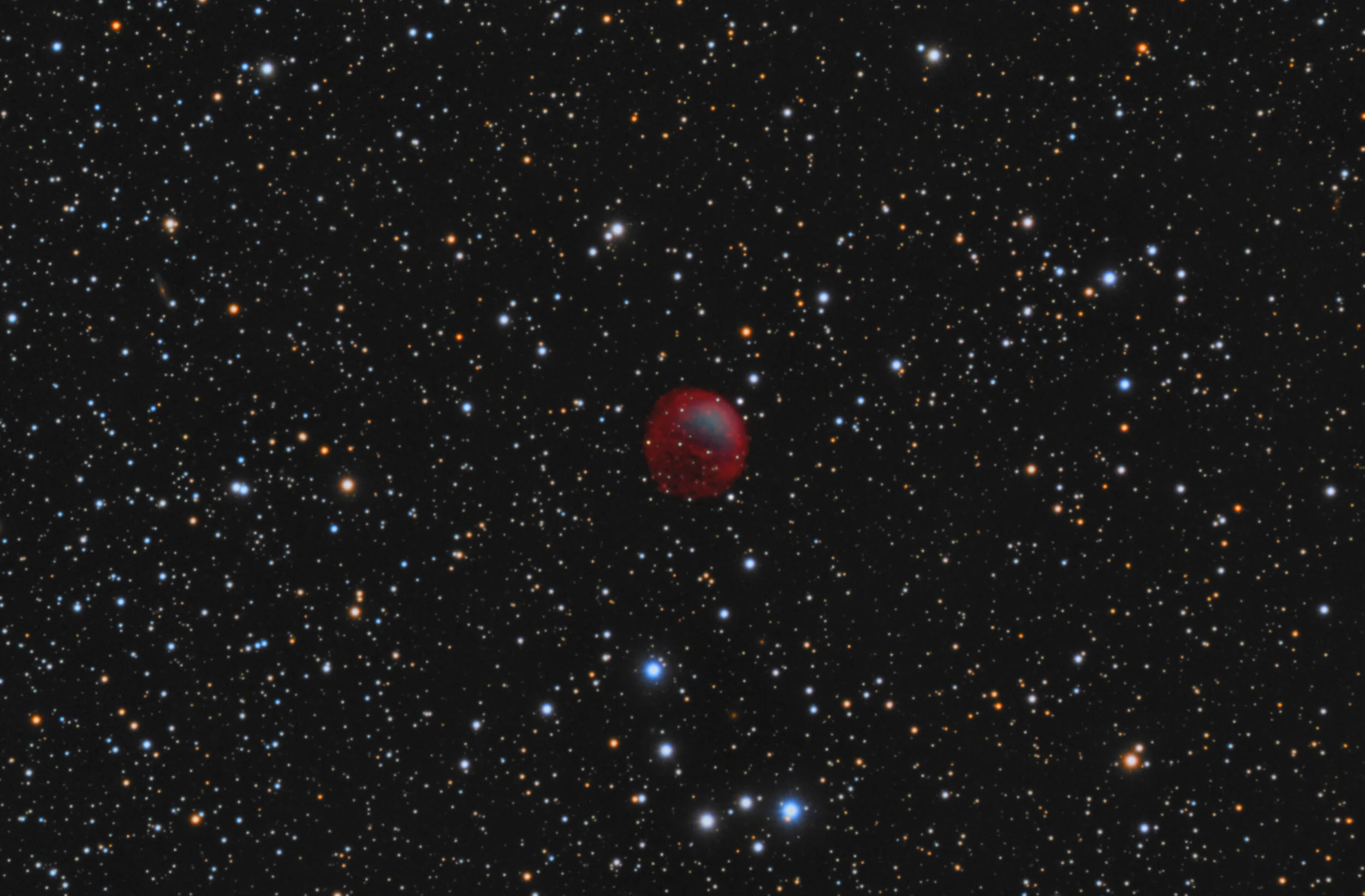
AAPOD2 Image Archives
Peter Goodhew
Featured Astrophotographer on AAPOD2
Discovery of a Bow Shock around Cataclysmic Variable Star LS Pegasi
A newly revealed bow shock surrounds LS Pegasi, a well-studied cataclysmic variable (CV) star in the constellation Pegasus. This reddish arc of emission was discovered through deep imaging and analysis of archival H-alpha and OIII data, confirming early suspicions from wide-field sky surveys. The emission structure seen here is a bow shock — a shell of material shaped by the motion of the star through the interstellar medium.
LS Pegasi has been known as a variable star since 1935, but it wasn’t until 1988 that it was classified as a CV, a system where a white dwarf accretes matter from a companion. In August 2020, amateur astronomer Dana Patchick detected subtle nebulosity around LS Pegasi using VTSS and SHASSA data, leading to targeted observations and the confirmation of this shock feature. The discovery contributes to a growing list of CVs with extended emission structures, suggesting mass-loss events or wind interactions that persist on large scales.
StDr 35 with Enigmatic WeSb 1 and Its Unusual Nucleus
Captured over 172 hours and 42 minutes in Ha, OIII, and RGB, this deep exposure showcases the planetary nebula StDr 35 alongside the enigmatic WeSb 1, an object with an unusually structured nucleus that remains poorly understood. Located in the rich star fields of Fregenal de la Sierra, Spain, this region presents a fascinating interplay between ionized gas and intricate stellar evolution processes.
WeSb 1 is particularly intriguing due to its non-standard morphology and spectral characteristics, suggesting a complex formation history. The central structure, likely influenced by a binary progenitor or interactions with surrounding interstellar material, exhibits unusual emission-line ratios that distinguish it from more typical planetary nebulae. The deep integration time in this image has allowed for the resolution of delicate outer shell structures and the faint ionized halos surrounding these nebulae, shedding light on the late evolutionary stages of their central stars. This observation contributes to ongoing efforts to understand the role of rare planetary nebulae in galactic chemical enrichment and stellar remnant dynamics.
NEW DISCOVERY: Strottner-Drechsler 33
New Discovery!
This first colour image of the probable planetary nebula StDr33 (PNG 201.6+03.9) shows a bright ring-shaped structure surrounding a whitish central star.
The central star is probably a close binary system in which two stars orbit each other. This is likely also the reason why the central star does not have the typical blue colour, as the spectral colours of both stars mix to a white-yellow. A total of 99 hours 25 minutes total integration (HaOIIIRGB)
Abell 30
Image Description and Details :
Abell 30 is a small (127 arc seconds) extremely faint planetary nebula located approximately 5,500 light-years away in the constellation of Cancer. Abell 30 is one of just three known nebulae called born-again planetary nebulae. Very rarely, nuclear reactions within the vicinity of a white dwarf can heat the gases to such high temperatures that the tiny star briefly becomes a red giant once more. This is a very brief phase, lasting a mere 20 years or so. The original nebula is estimated to be around 12,500 years old (which in itself is very brief in astronomical terms). The tiny features in the centre of the bubble are evidence of this re-birth. They are most probably comprised of helium and carbon-rich materials and were ejected around 850 years ago.The Ha signal is a featureless disk. All of the structural detail comes from the OIII signal. Image captured on my remote dual rig at Fregenal de la Sierra in Spain between 14 December 2021 - 9 January 2022.Scopes: APM TMB LZOS 152 Refractors Cameras: QSI6120wsg8Mount: 10Micron GM2000 HPSA total of 102 hours image capture (HaOIIIRGB)
Copyright: Peter Goodhew
Abell 13
Image Description and Details :
Abell 13 is highly evolved planetary nebula in Orion. It is sometimes known as the Orion Ring Nebula because it's morphology resembles the better known Ring Nebula, M57. However Abell 13 is much fainter at around mag 16. In both cases their oval shape is believed to be a result of them being bipolar nebulae viewed offset from their axis, making their ring structure appear oval. Abell 13 is 2.9 arc minutes in angular size and around 3,500 light years away. It was first catalogued as Abell 9 by George Abell in 1955, but renumbered as Abell 13 in his 1966 paper.
Image captured on my remote dual rig at Fregenal de la Sierra in Spain between 13-29 December 2021.
Scopes: APM TMB LZOS 152 Refractors
Cameras: QSI6120wsg8
Mount: 10Micron GM2000 HPS
A total of 53 hours image capture (HaRGB)
Copyright: Copyright: Peter Goodhew
Abell 33 - The Diamond Ring Nebula
Image Description and Details :
Abell 33 is a spherical planetary nebula located 2700 light years away in the southern constellation of Hydra. It lies just behind the star HD 83535. The star HD 83535 is responsible for the "diamond ring" effect seen in the photograph.Image captured on my dual rig in Spain.Scopes: APM TMB LZOS 152 RefractorsCameras: QSI6120wsg8Mount: 10Micron GM2000 HPSA total of 6.4 hours image capture (OIIILRGB)
Copyright: Peter Goodhew
Abell 34
Image Description and Details :
Abell 34 - a large (290 arc seconds) but very faint planetary nebula about 2400 light years away in the constellation Hydra. It's western rim is accompanied by two tiny distant galaxies.Image captured on my dual rig in Spain.Scopes: APM TMB LZOS 152 RefractorsCameras: QSI6120wsg8Mount: 10Micron GM2000 HPSA total of 25.8 hours image capture (HaOIIILRGB)
Copyright: Peter Goodhew
NGC 1501
Image Description and Details :
Another bright planetary nebula to capture during a full moon.
NGC 1501 is a complex planetary nebula in the constellation Camelopardalis.
It's progenitor star is a pulsating star, meaning that its brightness varies regularly and periodically. In the case of NGC 1501’s progenitor star, this is incredibly fast, with the star’s brightness changing significantly in just half an hour.
Image captured on my dual rig in Spain.Scopes: APM TMB LZOS 152 RefractorsCameras: QSI6120wsg8Mount: 10Micron GM2000 HPSA total of 7 hours image capture.
Copyright: Peter Goodhew
A Skull and Two Galaxies
Image Description and Details :
A two panel mosaic of NGC 246 - the Skull Nebula, spiral galaxy NGC 255, and dwarf galaxy PGC2689.Image captured on my dual rig in Spain.Scopes: APM TMB LZOS 152 RefractorsCameras: QSI6120wsg8Mount: 10Micron GM2000 HPSBlue: 60x300"Green: 58x300"Lum: 85x300"Red: 61x300"Total Integration: 22 hours
Copyright Peter Goodhew
NGC 7139 captured by a full moon
Image Description and Details :
NGC 7139 is a bright planetary nebula in the constellaton of Cepheus. Image captured on my dual rig in Spain during full moon.Scopes: APM TMB LZOS 152 RefractorsCameras: QSI6120wsg8Mount: 10Micron GM2000 HPSExposures:Ha 7x1800" and 48x900"OIII 48x900"Blue 20x300"Green 17x300"Lum 59x300"Red 16x300"Total Integration: 36.8 hours
Copyright: Peter Goodhew
Moon occulting Venus
At 09:18 CET this morning the planet Venus was about to pass behind the Moon. Imaging this by daylight was a bit of a challenge, especially as the sun was nearby, but using a short exposure (1/100th second) and a red filter managed to capture the moment just before Venus disappeared. Image captured using my robotic telescope in Spain.
Copyright: Peter Goodhew
M13 (Messier 13 )
Messier 13, a globular cluster of hundreds of thousands of stars, in the constellation Hercules. It is around 24,000 light years from earth, and approximately 145 light years in diameter.
Imaged during a full moon.
Astrodon Blue: 12x300"
Astrodon Green: 15x300"
Astrodon Red: 15x300"
Astrodon Luminance: 71x300"
Total Integration: 9.4 hours
Captured on my dual rig in Spain.
Scopes: APM TMB LZOS 152 (6" aperture 1200mm focal length)
Copyright: Peter Goodhew
HFG 1
HFG 1 is a very old large, low-surface-brightness planetary nebula in Cassiopeia. It surrounds, and was produced by, a binary star system (V664 Cas) that is moving rapidly through our Galaxy. V664 Cas is comprosed of a white dwarf star and a large red giant. The two stars are very close and rotate around their common centre of gravity every 14 hours. The star system is moving towards the lower left of the image. As HFG 1 plows through the interstellar medium, a bluish bowshock is produced; and a red trail of gas is left behind in its wake.
EQUIPMENT USED
Twin APM TMB LZOS 152 refractors
10Micron GM2000 HPS mount
Twin QSI6120 CCD cameras
Astrodon filters
IMAGE CAPTURE
5nm H-Alpha: 33x1800 bin 2x2
3nm OIII: 35x1800 bin 2x2
Luminance: 11x600 bin 1x1
Red: 10x300 bin 1x1
Green: 10x300 bin 1x1
Blue: 10x300 bin 1x1
Total integration: 38.3 hours
Pixel scale: 0.533 arcsec/pixel
Field radius: 0.351 degrees
Capture dates: 15 October - 6 November 2019
Capture location: Fregenal de la Sierra, Spain
Copyright: Peter Goodhew
Kn 63 (Kronberger 63)
Kronberger 63 is a planetary nebula in the constellation of Orion . It was discovered by Austrian Mattias Kronberger who is a member of the amateur group Deep Sky Hunters.
It is very faint and thus rarely imaged. Indeed my searches have found only one other image, produced by the Chart32 team in Chile.
Imaging telescope or lens: APM Telescopes TMB - LZOS Apo refractor 152/1200
Imaging camera: QSI 6120wsg-8
Mount :10Micron GM2000HPS II
Guiding camera: Starlight Xpress Lodestar Autoguider X2
Filters: Astrodon Blue, Astrodon Green, Astrodon Red, Astrodon SII 5nm, Astrodon 5nm H-Alpha filter, Astrodon Lum, Astrodon OIII 3 nm
Resolution: 3686x2267
Frames: Astrodon 5nm H-Alpha filter: 26x1800" bin 2x2 Astrodon Blue: 21x300" bin 1x1 Astrodon Green: 20x300" bin 1x1 Astrodon OIII 3 nm: 48x1800" bin 2x2 Astrodon Red: 20x300" bin 1x1
Integration: 42.1 hours
Astrometry.net job: 3153960 RA center: 5h 42' 5" DEC center: +4° 42' 50" Pixel scale: 0.534 arcsec/pixel
Orientation: 6.400 degrees
Field radius: 0.321
Locations: e-Eye, Fregenal de la Sierra, Extramadura, Spain
Data source: Own remote observatory
Remote source: e-EyE Extremadura
Copyright: Peter Goodhew
StDr 1
StDr 1 - a possible planetary nebula in the constellation of Taurus, discovered by Xavier Strottner and Marcel Drechsler in November 2019. This is the first time it has been imaged in color. It is extremely faint - and so 1800 second exposures binned 3x3 were necessary.
Astrodon Blue: 17x300"
Astrodon Green: 18x300"
Astrodon Red: 18x300"
Astrodon Lum: 21x300"
Astrodon OIII: 8x1800s bin 3x3
Astrodon Ha: 19x1800s bin 3x3
Total Integration: 20 hours
Captured on my dual rig in Spain.
Scopes: APM TMB LZOS 152 (6" aperture 1200mm focal length)
Copyright: Peter Goodhew

















